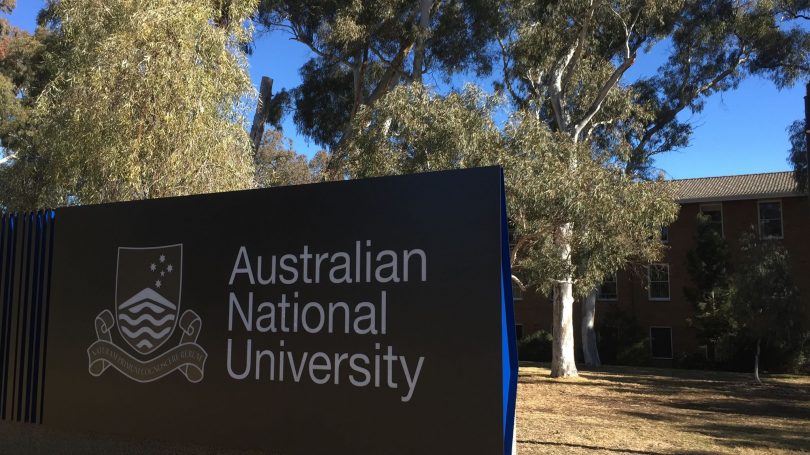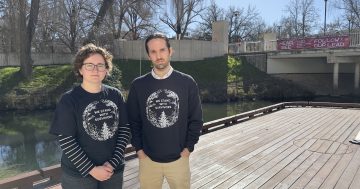
The Human Rights Commission Change the Course report found 57 per cent of students at ANU had been sexually harassed and 8 per cent had been sexually assaulted. Photo: File.
ANU Vice-Chancellor Brian Schmidt has released a long-awaited Sexual Violence Prevention Strategy (SVPS) to tackle sexual assault at the university after a 2017 study ranked ANU worst for the percentage of students who said they had been sexually harassed on campus.
The strategy will make it easier for students to report incidents of sexual violence and access support services and information on campus.
While the ANU Students’ Association has welcomed its release and congratulated student activists for years of advocating for a better response to sexual violence on campus, association president Eden Lim says more can always be done.
“It is important to be proud of this piece of work and what years of student advocacy has achieved today, but it is also important to recognise that it doesn’t stop here,” she says.
“Although delayed, we welcome the university’s fulfillment of their commitment to develop a sexual violence prevention strategy. This is a huge win for the countless students who’ve been campaigning for decades for justice for survivors and the cultural change required to tackle this issue.”
The strategy is being implemented across ANU in three phases between now and 2026, and will be overseen by the university’s new Respectful Relationships Unit (RRU), which was established in January to lead the effort to combat sexual violence.
Head of the RRU Sue Webeck says the strategy will build upon programs and procedures the university already has in place to reduce violence on campus to zero.
“The first phase of the strategy will identify what actions ANU has already taken to stop sexual violence while building on that and scaling successful initiatives across the campus,” Ms Webeck said.
“This will ensure we are working to stop sexual misconduct before it occurs while also responding effectively and with care when it does occur.”
It will be rolled out between now and the end of next year and will expand and evaluate measures the RRU has put in place to tackle sexual violence and harassment at the university.
Some of these measures include the use of online forms so incidents can be reported anonymously, the creation of a central data hub for sexual assault disclosures and reports, and specially trained first responder staff to immediately respond to cases of sexual misconduct on campus.
These initiatives aim to reduce sexual violence and better manage complaints and reporting when it does happen.
“We must work as a community and take individual, as well as institutional, responsibility for addressing sexual misconduct at our ANU,” Ms Webeck said.
“We must also ensure survivors know how they can make disclosures and reports of sexual misconduct both at ANU and in the broader community, and be confident in the knowledge that they will be supported.”
Following the revelations of sexual assaults on campus by the Human Rights Commission in its 2017 Change the Course report, ANU announced a review of its sexual assault and sexual harassment policies and procedures.
The report discovered that 51 per cent of all students had been sexually harassed at least once in the previous year, with ANU having the highest percentage of students who had been sexually harassed at university, and the highest percentage of students who had been sexually assaulted at university.
The report found 57 per cent of students at ANU had been sexually harassed and 8 per cent had been sexually assaulted.
Professor Schmidt says this is unacceptable and that a community-wide approach is needed to address the issue.
“Sexual assault and sexual harassment are never OK,” Professor Schmidt said. “These behaviours have no place at ANU. These behaviours must end.
“This strategy will guide the entire ANU community to address sexual violence at the individual, campus and whole-of-university level. Together we will target the structures, norms and practices that drive and reinforce sexual violence. Together we will tear these structures down.”
Community programs will challenge social norms towards violence and concepts of masculine stereotypes about sexual behaviour, educating and informing students about the harmful effects these messages can have.
The second phase of the strategy, from 2020 to 2023, will continue to streamline support services and reporting mechanisms to make it easier for students to find and access resources and help on campus.
Ensuring that the whole community has access to programs that provide effective intervention techniques to mitigate the threat of sexual violence will be integral to the success of phase two, according to Ms Webeck.
The third phase will be implemented between 2023 and 2026 and focus on maintaining and re-assessing the strategies the university has put in place to make sure they are working effectively and to see if they can be more efficient.
“Phase three is really about maintaining our efforts and ensuring they are firmly embedded in our practice and seeing real prevention results across the entire campus community. This is about making sure ANU is safe and inclusive for everyone,” Ms Webeck says.
















